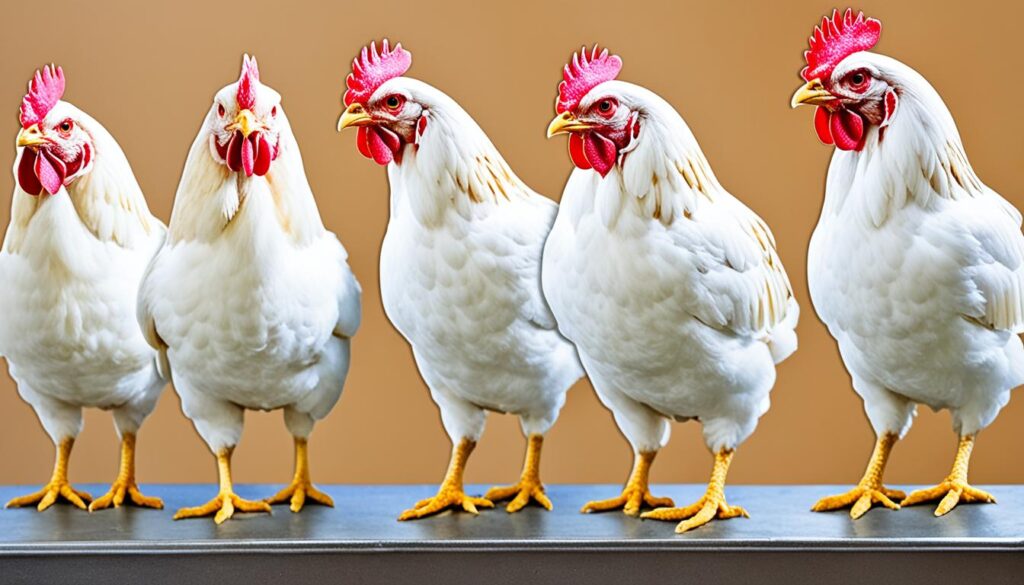When left untreated, a chicken with egg peritonitis may only survive a few days once symptoms become apparent. Understanding your flock’s health, particularly the intricacies of the chicken reproductive system, is pivotal for any backyard farmer. Egg Yolk Peritonitis (EYP) is a severe yet non-contagious condition that leads to inflammatory response within the peritoneal cavity, often due to the presence of yolk material from a ruptured or retained egg. Small backyard farm owners must be vigilant about poultry health issues like EYP, as it can severely affect not just the individual bird’s health but also the efficiency of egg production.
Being able to recognize the symptoms and having a baseline understanding of avian reproductive disorders will enable you to provide timely chicken veterinary care. This could be the difference between recovery and loss of a hen. Symptoms to watch out for include abdominal swelling, lethargy, and unusual droppings. In the communal space of a backyard coop, maintaining backyard chicken health becomes a shared responsibility between you and your trusted avian veterinarian.
Key Takeaways
- Early detection and intervention are critical in managing EYP.
- EYP symptoms include abdominal swelling and changes in laying behavior.
- Effective chicken veterinary care is vital for recovery and flock health.
- Non-contagious but serious, EYP requires an individual approach to poultry health.
- A comprehensive understanding of the chicken reproductive system aids in preventing and identifying health issues.
- Backyard chicken ownership includes a responsibility toward individual hen care and welfare.
Understanding the Causes and Recognizing Symptoms of Egg Peritonitis
As a hobby farmer, you’re likely familiar with the joys of collecting fresh eggs from your backyard chickens. However, egg laying can sometimes be accompanied by significant challenges, including Egg Yolk Peritonitis (EYP), which can be life-threatening if not identified and addressed promptly. Knowing what causes EYP and recognizing the symptoms are crucial steps in managing the wellbeing of your poultry flock.
Etiology: Why Egg Yolk Peritonitis Develops
Several factors may contribute to the onset of EYP in hens. During their peak egg-producing years, high levels of estrogen make hens vulnerable to a range of complications like salpingitis—a condition that can relax the sphincter muscles between the vagina and cloaca. Apart from this, disturbances such as oviduct impaction, obesity, and infections can interfere with the egg’s normal passage, leading to serious egg laying problems in chickens. It’s essential to understand that these disruptions not only affect individual birds but also potentially decrease overall poultry egg production.
Identifying Symptoms: Key Indicators of EYP in Hens
Spotting the symptoms of egg peritonitis in hens early can make a significant difference in outcomes. Signs to look out for include pale wattles or combs, aberrations like deformed or soft-shelled eggs, yellowish droppings, and a general decline in vitality or lethargy. These symptoms of egg peritonitis in hens may seem subtle at first but can escalate quickly, posing a question often asked by poultry enthusiasts: how long can a chicken live with egg peritonitis? Promptly recognizing these symptoms is crucial for timely intervention and ensuring the sustainability of your home-based poultry venture.
Co-Occurring Conditions: Additional Poultry Health Issues
Conditions that occur alongside EYP can further complicate the health of your hens. Ovarian disorders, tumors, and torsion of the oviduct are additional co-occurring issues that can aggravate the severity of peritonitis. Ignoring or delaying action when these symptoms arise can have a detrimental impact, leading to dire consequences for both the affected hens and the overall egg production of your backyard setup.
Indeed, nurturing a healthy flock requires vigilance and a commitment to understanding both the biological and environmental factors that contribute to the wellbeing of your chickens. Armed with this knowledge, you can take proactive steps to minimize the incidence of EYP in your backyard poultry and ensure your hens lead productive, healthy lives.
How Long Can a Chicken Live with Egg Peritonitis
The lifespan of a chicken grappling with Egg Yolk Peritonitis (EYP) hinges on the quickness of detection and initiation of treatment. As a hobby farmer, understanding the real impact of this condition on your backyard chicken health is paramount. If left untreated, how long can a chicken live with egg peritonitis? Regrettably, the prognosis is disheartening as these birds may succumb swiftly, sometimes within 48 hours, particularly when complications such as egg binding arise.
Assessing Prognosis: Factors Influencing Survival
Various factors play into the survival chances of hens afflicted by EYP, making vigilant attention to chicken veterinary care a necessity. The course of action you take upon noticing the early signs can dramatically alter the outcome for your feathered charges. A timely visit to the veterinarian can lead to successful interventions such as administering treatment for egg peritonitis, which may include antibiotic therapy or surgical procedures if necessary.
Advanced Stages: Symptoms and Quality of Life Considerations
Recognizing the advanced stages of EYP can be gut-wrenching. You may notice your birds displaying significant abdominal swelling or adopting a penguin-like stance, indicative of their discomfort. At this juncture, the bird’s quality of life is severely compromised. Here, the decisions you face revolve not just around health, but also ethics, possibly leading to humane euthanasia for severe cases of avian reproductive disorders like EYP, to prevent unnecessary suffering.
Emergency Care: Understanding When to Seek Veterinary Assistance
The welfare of your backyard flock is an ongoing commitment that may require emergency interventions. Acknowledge when symptoms of EYP become apparent and pursue emergency care promptly. Such preemptive actions ensure the sustenance of robust poultry health and maintain productivity in your home flock. Always opt for veterinary guidance to navigate these challenging health scenarios and protect the well-being of your backyard chickens.

